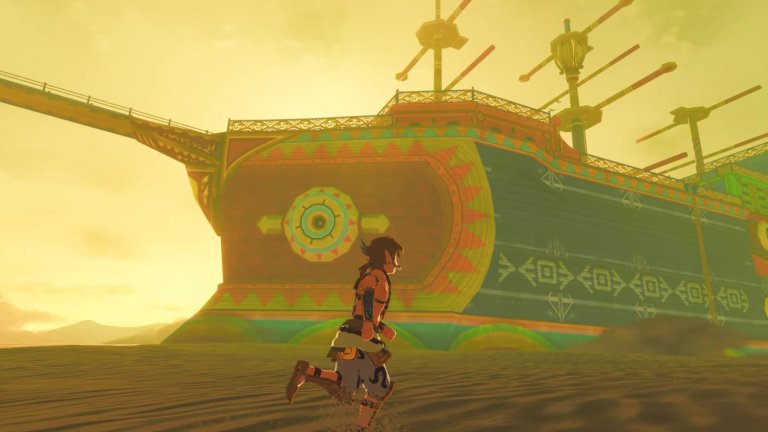Skyward Sword HD Proves That Future Zelda Games Need Traditional Dungeons
Should Breath of the Wild 2 feature the kind of classic dungeons that make Skyward Sword so memorable?

Rather than run to the nearest beach in search of some sun, I spent the majority of this past weekend playing The Legend of Zelda: Skyward Sword HD on Nintendo Switch. I simply couldn’t resist the opportunity to revisit a classic (if divisive) Zelda game.
“Classic” is certainly the keyword here. Unlike Breath of the Wild’s free and open atmosphere, Skyward Sword emphasizes a somewhat telegraphed fantasy adventure made in the mold of Ocarina of Time, Twilight Princess, and other, more traditional, 3D Zelda entries. Are there drawbacks to that template? Sure, but utterly excellent dungeon design isn’t one of them.
Walking into Skyview Temple, the game’s first dungeon, I was instantly reminded of just how mesmerizing those large-scale puzzle boxes can be. It especially hits home at that moment since, up until that point, the game inundates you with character conversations, petty fetch quests, and combat tutorials, barely allowing you to discover things naturally. Now, though, amongst the ominous stone structures and luminous fauna, I’m finally let off the leash and am more than ready to rescue Zelda by doing the things Link does best: explore and seek out creative solutions.
There’s something magical about stepping into an unknown space with numerous challenges ahead while still feeling secure in the knowledge that you already possess all the tools you need to progress. From there, the onus is on you to use each one appropriately until you can satisfyingly pick away at the mystery located at the dungeon’s center. Openness and intrigue are what make good Zelda dungeons so memorable, and that is why those dungeons were a staple of the series up until 2017.
For all its brilliance and genre-defying conventions, Breath of the Wild’s version of Hyrule sorely lacked much of the awe and wonder offered by those classic-style dungeons. Instead, they were replaced by the much more insular and streamlined shrines, which were a nice reward for venturing into the farthest reaches of the map, but were extremely hit or miss in terms of how fulfilling they were to complete. The best shrines would challenge you to use all six of Link’s Shiekah Slate abilities in ways you never previously thought possible. The worst would present you with yet another Guardian Scout to defeat. Where’s the wonder in that?
No such irregularity exists in Skyward Sword’s dungeons, and that’s mainly because those big set piece areas were carefully designed with pace, structure, and flow in mind. The Ancient Cistern, for instance, sets a new standard for water dungeons in a Zelda game by gifting Link with a whip that changes how you view and navigate the game’s world. Before acquiring that nifty gizmo, hopping around on lily pads or clambering up grass walls was an often cumbersome (but necessary) process. With that item in hand, though, you’re suddenly lashing up and down the titular cistern with grace. It’s a masterclass in showcasing growth in a small space of time.
Whereas Ocarina’s water temple infamously forced players to constantly take their iron boots on and off to get around, the Ancient Cistern learns from past mistakes by making traversal be a breeze. The Whip is even used as a key part of combat scenarios as well as puzzle-solving (as all the game’s best items are). No Shrine in Breath of the Wild benefited from building up an item or power quite like that, as Link’s toolset in that game is essentially complete from the start. You can explore those shrines in any order at any time, which works well for spontaneity, but the absence of Nintendo’s strict authorship does mean that the complexity of those puzzles somewhat levels out.
Another great example of Skyward Sword’s sense of momentum happens early on in Skyview Temple when you come across a locked door with a wandering eye located above it. Most Zelda games would ask you to shoot the eye in order to unlock a passage, but in Skyward Sword, moving to the next room requires Link to wave his mighty sword around and around, confusing the eye until it’s forced to give up. Voila! Such a puzzle would be the centerpiece of one of Breath of the Wild‘s shrines, but here, it’s simply an opportunity to learn this mechanic and then carry that knowledge forward with you to use elsewhere.
In addition to their smart mechanical design, Skyward Sword‘s dungeons feel thematically unique from each other. One minute you’re dodging the danger of liquid-hot magma by rolling along with a giant ball in the Earth temple, and the next, you’re hopping across hundreds of years of Hyrule history while trying to get the Lanayru Mining Facility up and running. Visually, the classic Zelda dungeon format always offers something fresh to look forward to. By comparison, shrines and Divine Beasts feel like they’re cut from the same cloth.
There are, of course, benefits to both approaches, but there’s no reason why future Zelda games can’t benefit from a mixture of shrines, divine beasts, and dungeons. I hope that Nintendo embraces such a format for Breath of the Wild 2 or whatever comes after. It would make the lack of creativity in shrines less of an issue since the real meat of Zelda’s puzzle design ethos could be conceived, built up, and then delivered within a more conventional dungeon format. Such an approach could be one of the few instances where quality and quantity are allowed to exist in harmony.
Breath of the Wild was a clear (and clearly successful) response to the backlash over the overt linearity of certain Zelda games. While Skyward Sword truly does represent one of the worst examples of that linear design philosophy (outside of its dungeons), I can’t help but feel like puzzles in this series will always be more meaningful when they’re treated as proper spectacles rather than something to be finished and then thrown away. There’s a reason Skyward Sword’s dungeons are typically remembered more fondly than any puzzle in Breath of the Wild, and the game’s HD remaster reminds us that Zelda‘s dungeon designers were at the top of their game when this series suddenly went in a different direction.
